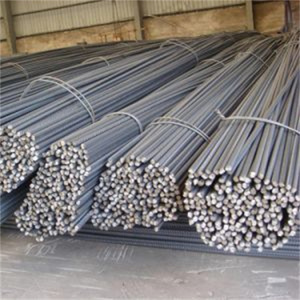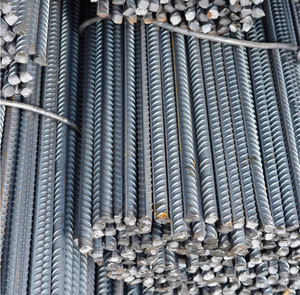
All categories
Featured selections
Trade Assurance
Buyer Central
Help Center
Get the app
Become a supplier

(14982 products available)








































Rebar, short for reinforcing bar, is a steel bar or mesh of steel wires used as a tensioning device in concrete structures to bear tension. In all kinds of concrete structures, which are usually heavy, such as highways, skyscrapers, bridges, and buildings, the reinforcing steel bars are often set into concrete to strengthen it from cracking and breaking.
16 mm rebars are medium-sized bars used in small to medium construction, providing solid reinforcement with moderate flexibility. It is available in several types, having different mechanical and chemical properties to suit specific requirements:
Carbon Steel Rebar
Carbon steel 16 mm rebar is the common type and is often simply referred to as concrete reinforcement steel. It is made of a carbon and iron mixture, and its surface is patterned with ribs for good concrete bonding. It is very strong, can stretch with some degree, and is relatively cheap compared to other types. However, it is prone to rust and is unsuitable for moist places unless coated or treated.
Ekonomic Rebar
Ekonomic rebar is a hot-rolled steel bar shaped with ribs and twists to maximize mechanical bond properties with concrete while minimizing material usage. The bar reduces weight without losing strength, making it ideal for budget-saving yet safe construction projects. Its unique rib design facilitates superior concrete grip, ensuring lasting durability and dependable performance in structural applications.
Galvanized Rebar
Galvanized 16 mm bars are carbon steel bars coated with a thin layer of zinc through hot-dip or electro-galvanizing processes to prevent rust and corrosion. This type is ideal for applications in which the concrete structure will be in contact with soil or moist air that catalyze oxidation. It can also be used in architectural concrete for aesthetic purposes.
Epoxy-coated Rebar
This is a type of carbon steel rebar coated with a layer of epoxy resin, an electrostatically applied thermosetting polymer. The coating provides excellent corrosion resistance properties. It is primarily intended for concrete structures located in highly corrosive environments such as coastal areas, chemical plants, or near de-icing salts.
Stainless Steel Rebar
Stainless steel rebar is a high-alloy steel bar with chromium, nickel, and other corrosion-resistant elements. It is extremely resistant to rust and corrosion, even in harsh chemical and marine environments. While its cost is relatively high compared to carbon steel, its longevity and maintenance savings make it economical over the longer term for special applications.
Fiberglass Rebar
Fiberglass rebar is a high-strength, lightweight composite bar made from glass fibers and resin epoxy, usually with a metal core. It is non-corrosive, a great alternative to steel rebar in high-moisture, acidic, or saline environments. Its electrical non-conductivity makes it suitable for applications in power generation and telecommunications while being much lighter for easier handling and installation.
Choosing appropriate rebar requires knowing its different types and properties to suit construction needs:
Environmental Conditions
Environmental conditions are a major factor when choosing rebar. Moisture content and soil type, as well as chemical exposure level, should be considered before choice. If working in moist, saline, or chemically active soils, opt for stainless steel or epoxy-coated rebar, as these will guarantee long-term durability contrary to carbon or black rebar, which are less adapted to such environments.
Load-Bearing Requirements
Anticipated load within the structure should also be factored in, since it determines how much rebar alternations should be made. Heavily loaded structures like bridges, high-rise buildings, and parking garages require higher grade or larger diameter rebars for greater tensile strength. Check the structural engineering designs and follow the specified bar size, spacing, and grade.
Concrete Thickness
The bar size should also be relevant to the thickness of the concrete. Generally, the diameter of the bar must be at least one-fifth the thickness of the slab, to make sure that adequate tension reinforcement is obtained. In other words, 16mm rebar is suited for slabs having a minimum thickness of 200 mm, and other thicker concrete structures.
Cost Considerations
Cost effectiveness is also a major factor, as well as whether to go for carbon steel or special types like stainless steel or galvanized, which come with additional costs. Although initially the cost of treated rebars would be higher, the long-term savings in maintenance and replacement in the right environment may offset this expense. Budget constraints should be aligned with performance and durability requirements.
Corrosion Resistance
Corrosion resistance is another important consideration when choosing rebar, especially in areas of high humidity or near the sea. Galvanized and epoxy-coated steel and stainless bars are very suitable for these kinds of applications. Meanwhile, using carbon steel is good for a majority of applications with modest exposure to moisture, since it is relatively cheaper.
Bonding with Concrete
The surface of the rebar is also important in terms of bonding with concrete. Ribs are patterned on it to enhance its bonding with the surrounding concrete mass. High ribbed rebar creates rougher surface, which improves mechanical interlocking better than a plain bar. Adeate bonding is critical to ensure that stress is evenly distributed across the structure.
Rebar is a significant ingredient of concrete construction, especially in providing tensile strength. It has a wide variety of applications:
Highways and Bridges Construction
Rebar is indispensable in highway and bridge construction, since concrete provides compressive strength and the rebar provides tensile strength. It ensures the structures are able to have the load-bearing capacity required and stress expanded without cracking or warping, even under heavy traffic and changing temperatures. The use of 16 mm rebar in this application balances strength and flexibility, making it suitable for reinforcing thick concrete slabs and beams.
High rise Building
In the case of high rising buildings, 16 mm rebar is used to ensure structural integrity as well as stability. These bars are used in reinforced concrete beams, columns, and slabs, enabling the concrete to support the weight of the building itself, as well as external loads like furniture, wind, and even earthquakes. Its diameter is ideal for tension and compression within thick concrete elements, maintaining a balanced load distribution throughout the structure.
Industrial and Commercial Flooring
In industrial and commercial applications, 16 mm rebar is used in the flooring system. Factories, warehouses, and commercial garages lay reinforced concrete slabs that can withstand heavy equipment, vehicle traffic, and point loads. The rebar evenly distributes these loads across the slab, preventing cracking, sinking, or uneven wear. It also provides a longer lifespan to the floor under conditions of high pressure and stress.
Parking Garages
Parking garages are among the structures where concrete with rebar is extensively used, as well as bridges and high-rise buildings. 16 mm rebar helps in withstanding loads from vehicles as well as lateral pressure from winds and other forces. It ensures that the slabs, walls, and columns remain stable and have the capacity to support dynamic loads and the garage's own weight without giving in to cracks.
Water Retaining Structures
Rebar is important for any structure where concrete must retain water, such as reservoirs, water treatment plants, and swimming pools. It reinforces the concrete to resist hydrostatic pressure and keep the structure intact. In areas of heavy water pressure, 16 mm rebar is ideally sized to help balance pressure from within and outside, preventing leaks, cracking, and ultimately failure of the structure in its retention of water.
Product specifications and features of 16 mm rebars:
Diameter
A 16 mm rebar has a diameter of 0.63 inches, or approximately 5/8ths of an inch, which places it in the mid-range size category for reinforcing bars. This diameter is suited for many applications and provides a balance between strength and flexibility. Also, the size makes it easy to handle during construction and is compatible for many concrete mix designs.
Length
Typical lengths of 16 mm rebar bars are from 10 to 20 feet, or about 3 to 6 meters. Standard lengths could possibly be cut to suit specific project requirements. Standard lengths or shorter lengths make handling easier during construction, especially in sites that do not have much space compared to working with longer pieces.
Tensile Strength
In general, tensile strength of 16 mm rebar is about 60,000 psi or around 415 MPa. This value is a measure of the bar's ability to hold up to stretching or pulling without breaking. It is ideal for reinforcing concrete, since concrete is strong in compression but weak in tension. The tensile strength allows the reinforced slab to carry more load before failure occurs.
Yield Strength
Yield measurement of strength for 16 mm rebar is usually around 40,000 pounds per square inch or 275 MPa. Yield strength is defined as the point at which the material will begin to deform permanently. It is critical in construction because the load applied to the concrete slab should never exceed this value, as doing so risks bending or warping the rebar and compromising the slab's integrity possessing the potential to cause structural failure.
Weight
16 mm rebar weighs approximately 1.74 pounds per foot or about 2.58 kilograms per meter. The weight affects handling, transportation, and installation processes all through construction. Additionally, it affects the load-bearing capability of the concrete slab: a heavier bar means more steel and thus greater load it will support without adding significant mass to the structure.
Material Composition
Usually, 16 mm rebar is carbon steel, a combination of iron and carbon with around 2% carbon content. Thus, it makes the bar very strong and ductile. Carbon steel is ideal in general construction applications since it is affordable and provides great bonding with concrete. Some rebars are also treated with corrosion-resistant coatings.
Surface Features
The surface of 16 mm rebar features patterned ridges or ribs running longitudinally and transversely across the bar. The ribs enhance mechanical interlock between the rebar and surrounding concrete. It ensures proper load is transferred from one element to the other. Surface profiling is important to provide a bonding mechanism so that tension is evenly distributed throughout the structure.
A1. 16 mm rebar is primarily used for medium to large concrete construction projects. It helps reinforce structures like pavements, bridge decks, building slabs, foundations, and retaining walls. It balances strength and flexibility, making it ideal for applications where concrete bears heavy loads requires tensile strength, and undergoes temperature fluctuations.
A2. Compared to other sizes, 16 mm rebar strikes a balance between strength and ease of handling. It is ideal for many structural and pavement applications. Smaller bars provide less tensile strength but are easier to maneuver. Larger bars increase load-bearing capacity and greater tensile strength. The choice depends on factors like concrete thickness, project scale, and load requirements.
A3. Regular carbon steel rebar is prone to rust in moist environments. However, 16mm rebar is available in corrosion-resistant varieties. These include epoxy-coated, galvanized, and stainless steel rebar. They are designed specifically for harsh environments. These include coastal areas or chemical plants. They extend the lifespan of concrete structures by preventing corrosion.
A4. During installation, steel bars are placed in concrete forms according to engineering specifications. They should be properly spaced and secured to prevent movement during pouring. A concrete vibrator is used to ensure proper settlement around the bars. Once curing is complete, the rebar and concrete work together to bear loads and provide structural integrity.
A5. Commonly, rebar is made from steel, an alloy of iron and carbon. Steel provides superior tensile strength. That is the capacity to resist pulling forces. It is difficult to stretch or snap. They include plain and patterned rebars designed by specific engineering standards. Carbon is used in a proportionate ratio with other materials to enhance ductility and bonding properties.